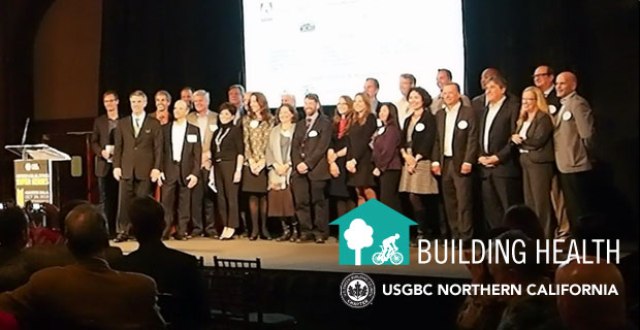Oct 31 2013
Adobe, CalPERS, Genentech, Google, Kaiser Permanente, salesforce.com, University of California, San Francisco (UCSF) and 20 other corporations and institutions are committed as founding partners in a fast-growing movement to elevate green building as a public health benefit and accelerate the development of transparency standards in building materials.
 Representatives from 27 Founding Partner Companies at Initiative Launch
Representatives from 27 Founding Partner Companies at Initiative Launch
The U.S. Green Building Council-Northern California Chapter (USGBC-NCC) officially launched the Building Health Initiative last night at its annual Super Heroes Awards Gala. Featuring a diverse array of actions, the initiative will facilitate sharing of best practices and collaboration among a unique coalition of commercial building owners and tenants; architects, engineers and builders; building product manufacturers; legal professionals; labor and healthcare professionals and institutions.
“This is the first time major corporations and institutions from multiple sectors have come together to publicly commit to improving human health through green building,” said Dan Geiger, executive director of USGBC-NCC. “Each partner has pledged to implement new organizational actions that have direct effects and generate awareness of how the built environment affects our well-being. This is a tremendous stimulus for the movement for healthy communities for all.”
Initiative advisory board member Elizabeth Baca, M.D., M.P.A., a physician engaged in policy to improve the built environment, said, “There is a growing recognition in medicine that the built environment has significant health impacts. Physicians want to understand the underlying causes of their patients' conditions. That's why we ask, ‘Where do you work, live and play?’ It is imperative that the medical profession and building industries learn from one another about the health impacts of the built environment.”
As part of phase one of the initiative, Adobe, Genentech, Google and salesforce.com have pledged to develop procurement practices and processes that consider materials transparency and emerging standards such as Health Product Declarations (HPDs). In addition, Adobe will study its LEED certified workplaces to determine if they measurably contribute to more collaborative, creative, innovative and healthy employees. Other partner pledges include creating resources for affordable housing, community outreach, researching the relationship between climate change and health, educating clients and peers about health impacts of the built environment and developing Environmental Product Declarations (EPDs).
Phase two of the initiative will be a series of educational programs and events held over the next two years, including best practice sharing and inter-disciplinary programs developed with the founding partners.
“We are excited to be a partner in this pioneering effort to improve the health of our global communities,” said Anne Stausboll, chief executive officer of CalPERS. “Acting in concert with like-minded organizations to push for the growth of communities and buildings that improve the health of those areas fits in with our own work to ensure the health of our members and their families.”
“Genentech is gratified and excited to be part of USGBC’s Building Health Initiative,” said Carla Boragno, vice president of site services, Genentech. “As an organization committed to improve human health, we also want to promote the development of environments that contribute to the health and wellness of our employees and communities where we work.”